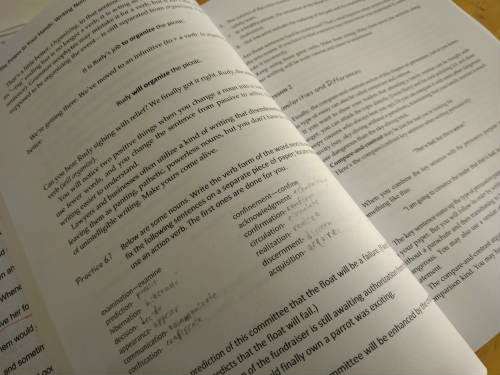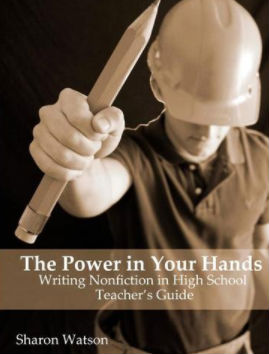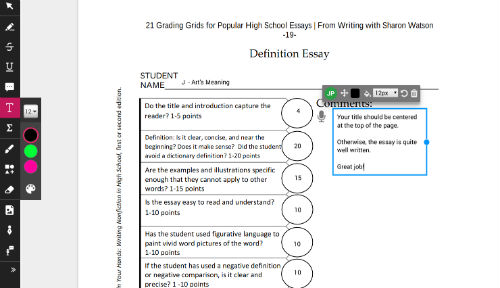I am about to let you in on a secret. I do not enjoy teaching every subject; one in particular is my kryptonite. It is not math; even though math challenges many homeschool moms, I happen to enjoy it and love sharing my passion for numbers with my kids. I can handle history and science just fine, unless you throw in the mess of experiments. I do not mind teaching English grammar because it flows logically—most of the time. But the hardest one for me to teach is writing.
I can hear you now: “Wait! How can you be a blogger and not enjoy writing?” The issue is not that I can’t write. I just have a hard time teaching it.

Whenever I read my son’s completed writing assignment, I can always see myriads of possible improvements he could make. They practically jump off the page at me! Of course, when I start scribbling with a red pen all over his careful work, his face falls, and he never wants to write again. Somehow, my oldest daughter became an excellent writer despite my drive for perfection, but she does not enjoy the subject and thinks she can not write well.
During fourteen years of homeschooling, we have tried several different writing curricula, mostly without success. I have avoided assigning much writing because my kids are such reluctant writers, and it is so hard for me to evaluate their work without killing their love of learning.
A couple years ago I realized the importance of preparing my high school son to write in college and the real world. I did not like the way his English curriculum assigned writing without fully teaching the writing process, and I needed extra support to know how to appropriately evaluate his work. I searched through curriculum websites and eventually discovered a simple and complete curriculum called The Power in Your Hands.

The Power in Your Hands
The Power in Your Hands writing curriculum has revolutionized writing for me and my son. The core of the program is a workbook that explains step by step how to complete various types of writing assignments. The variety of writing introduced in the book is truly astounding—from writing a short devotional to literary analysis to a research-based paper and everything in between.

My son reads a lesson each day, answering questions and practicing new skills along the way. At the end of each chapter, he spends a week or more completing a writing assignment to put into practice what he has just learned. Other curricula we have used required a writing assignment each week; we were both relieved that The Power in Your Hands teaches writing so effectively without overwhelming him with weekly papers or essays.
As my son has worked through the book, his dread of writing has lessened. Putting his thoughts on paper has become easier for him, and his writing has improved tremendously. In the past, he had trouble constructing a two-sentence paragraph (which I tried to convince him was not a paragraph at all); he can now easily expand his thoughts into well-written 400 to 600 word papers.

How Do I Grade My Son’s Writing?
The Power in Your Hands Teacher’s Guide includes a grading rubrics specific to each assignment. This tool has made scoring much easier for me. Don’t get me wrong—I still procrastinate on grading my son’s writing. Honestly, I dread it and usually put it off as long as possible.

When I evaluate his work, I am usually pleasantly surprised. As read through the work he has handed in and record the appropriate scores on the rubric, I realize what an excellent writer he is becoming. I have to take off points here and there where he did not completely follow a particular instruction, but many times I am able to give him extra credit for going above and beyond what was required.
Recently, I discovered downloadable grading rubrics that the author, Sharon Watson, sells on her website. These saved me from having to reproduce the rubrics that are included in the print version of the Teacher’s Guide. The digital format is a major time-saver.

Although I could print and complete the rubrics with a pen, it is more convenient to fill them in on the computer. I save a copy of the page I need as a new PDF (using print to file) and then use software such as Adobe Acrobat or Kami to annotate it, clicking wherever I need to add scores or comments.
Little did I know that simply by scoring his work, I would pick up by osmosis many of the things he was learning in his lessons. While my son’s writing has improved, I have leveled up in my own writing and become bold enough to share it with the world on my own blog.
Digital or Print?
When I purchased The Power in Your Hands a couple years ago, I could not find a digital edition. Now the Student Workbook and Teacher’s Guide are both available as ebooks. Grading rubrics are included in the Teacher’s Guide but can also be purchased and downloaded separately—truly a must when using with a print edition.
I plan to use this course to some degree with my three younger daughters as well. To save on time and the cost of toner, I will probably purchase print versions of the 400-page workbook for them. Although I would not mind a digital version of the Teacher’s Guide, I will probably use the print version I already own.
Sharon offers suggestions for using the course as a one-year high school course. However, it takes longer than a year to complete every chapter and assignment. My son worked hard during his junior year and completed about two thirds of the book. I awarded him a complete English credit. To earn a final credit during his senior year, he is completing the remainder of the book at a more relaxed pace alongside a semester-long American Literature course. It is a great way to wrap up high school English and prepare him for a future in which he will certainly need to write well.